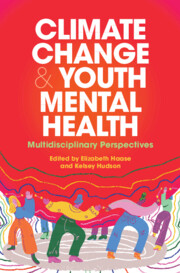Book contents
- Climate Change and Youth Mental Health
- Climate Change and Youth Mental Health
- Copyright page
- Contents
- Figures
- Tables
- Textboxes
- Contributors
- Preface and Introduction
- Considerations
- Acknowledgments
- Part I Conceptual Foundations of Climate Distress in Young People
- Part II Multidisciplinary Perspectives on Youth Climate Distress
- Chapter 10 Therapists’ Perspectives
- Chapter 11 Ecological and Intersectional Perspectives to Reduce Young Adults’ Climate Distress
- Chapter 12 Pediatricians’ Perspectives
- Chapter 13 A Legal Perspective on Judicial Remedies to Respond to Young People’s Climate Distress
- Chapter 14 Coping with Climate Change among Young People
- Chapter 15 Social-Ecological Perspectives and Their Influence on Climate Distress in Young People
- Chapter 16 Parenting and Grandparenting Our Youth in the Climate Crisis
- Chapter 17 Perspectives on Addressing Young People’s Climate Distress in Education
- Chapter 18 Activists’ Perspectives
- Chapter 19 Perspectives from Creative Spaces
- Chapter 20 Landback
- Chapter 21 Future Directions
- Appendix A Resource List for Educators
- Appendix B Costs and Benefits of Activism Scale
- Index
- References
Chapter 18 - Activists’ Perspectives
Using Climate Activism to Heal Youth Climate Distress
from Part II - Multidisciplinary Perspectives on Youth Climate Distress
Published online by Cambridge University Press: 06 June 2024
- Climate Change and Youth Mental Health
- Climate Change and Youth Mental Health
- Copyright page
- Contents
- Figures
- Tables
- Textboxes
- Contributors
- Preface and Introduction
- Considerations
- Acknowledgments
- Part I Conceptual Foundations of Climate Distress in Young People
- Part II Multidisciplinary Perspectives on Youth Climate Distress
- Chapter 10 Therapists’ Perspectives
- Chapter 11 Ecological and Intersectional Perspectives to Reduce Young Adults’ Climate Distress
- Chapter 12 Pediatricians’ Perspectives
- Chapter 13 A Legal Perspective on Judicial Remedies to Respond to Young People’s Climate Distress
- Chapter 14 Coping with Climate Change among Young People
- Chapter 15 Social-Ecological Perspectives and Their Influence on Climate Distress in Young People
- Chapter 16 Parenting and Grandparenting Our Youth in the Climate Crisis
- Chapter 17 Perspectives on Addressing Young People’s Climate Distress in Education
- Chapter 18 Activists’ Perspectives
- Chapter 19 Perspectives from Creative Spaces
- Chapter 20 Landback
- Chapter 21 Future Directions
- Appendix A Resource List for Educators
- Appendix B Costs and Benefits of Activism Scale
- Index
- References
Summary
This chapter by Jennifer Uchendu and Elizabeth Haase is dedicated to children and youth-led activism, with a focus on Jennifer’s journey as a youth climate activist leading work at SustyVibes in Nigeria. SustyVibes is a youth-led and youth-focused organization making sustainability actionable and relatable for young people through community-led projects. The chapter chronicles aspects of Jennifer’s journey that may be significant for young people and researchers of youth activism. We also discuss the main types of activism and highlight principles that have been adopted by youth climate activist groups to help them be most inclusive and effective, preventing burnout and group devolution. Drawing from Jennifer’s experience with eco-anxiety and related stress, we review the literature on the risks and benefits of activism – for youth mental health and for youth climate activists in particular – in hopes that her story can be generalizable and empowering to others.
Keywords
- Type
- Chapter
- Information
- Climate Change and Youth Mental HealthMultidisciplinary Perspectives, pp. 347 - 366Publisher: Cambridge University PressPrint publication year: 2024

